(Ahead of this weekend’s Long Beach Grand Prix, we pulled a lovely piece from the cupboard. Two years ago, Preston Lerner profiled the Toyota Pro/Celebrity Race. Since 1975, the race served as the action-packed undercard to sports car racing’s Long Beach takeover. Actors, start your engines.)
* * * * *
The invitation to compete in the Toyota Pro/Celebrity Race materialized in Perry King’s mailbox out of the blue. Thirty-six year later, he still remembers its tantalizing proposition.
Have you ever wondered what it would be like to be Mario Andretti?
“I had wondered about it many times!” King tells me, geeking out like a super-obsessed teenager. “I was overwhelmed with gratitude when I received that invitation.”
At the time, King was a huge star on the TV series Riptide, and he’s worked so consistently ever since that you could go cross-eyed reading his IMDb page. He ended up running in the pro/celebrity race in Long Beach not once, not twice, but four times. This experience turned out to be the gateway drug that led him into pro racing, culminating in an appearance in the 24 Hours of Daytona with fellow actor Lorenzo Lamas. But the pro/celebrity race in 1996 is the one that sticks in his mind—and in his craw.
“I took the lead, and the car began experiencing fuel starvation,” he recalls. “I had the race won, and the damn car started sputtering. That was 30 years ago, and I’m still pissed off about it.” Then he laughs. He realizes that it sounds ridiculous, but you know what they say about truth being stranger than fiction. “I don’t think there’s anything in my life that I miss more than the pro/celebrity race,” he says. “I loved the training. I loved the practices. I loved the races. Everything about it was glorious. I’d give anything to do it again.”
Alas, the pro/celebrity race is no more. Toyota last held the mash-up in 2016, not long before withdrawing as the longtime title sponsor of the Long Beach IndyCar weekend. Nowadays, the event is known officially as the Acura Grand Prix of Long Beach, and this year’s lineup—held later this month instead of April because of the pandemic—includes Indy cars, IMSA, drifting, Robbie Gordon’s crazy Super Trucks, Global Time Attack and vintage Formula Atlantics. But the pro/celebrity race will be missing from its traditional Saturday morning time slot, and busy as the weekend is, I can’t help thinking that there’s a gigantic hole in the schedule.
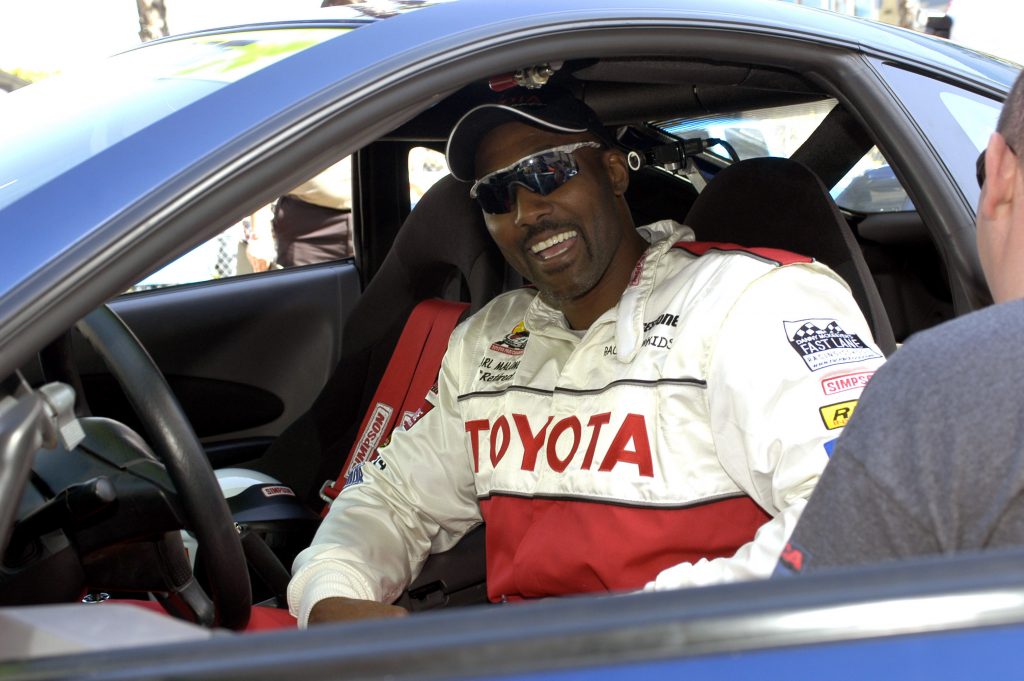
Retired NBA great Karl Malone gets ready to qualify for the 2005 Toyota Pro/Celebrity race in Long Beach. (Jonathan Alcorn/WireImage via Getty)
The first thing you need to know about the Toyota Pro/Celebrity Race is that the concept was pure genius: Put a dozen or so big-name actors, musicians and athletes with no racing experience in identical cars. Add a quartet of pro drivers starting 30 seconds behind the celebrities. Then let the motorsports version of The Hunger Games begin! If all went according to plan, the pros would scythe through the field and reach the rear bumpers of the leading celebs just as the white flag was being unfurled.
The races featured drama, comedy, and so much mayhem that Toyota kept Gardena Body Shop on retainer for the weekend. “That business kept them afloat for years,” says Chuck Wade, who was in charge of building—and rebuilding—the cars. Largely because the amateurs knew just enough to be dangerous, the action was wildly entertaining. And even during those years when the celebs were mostly B- and C-listers, they still generated plenty of buzz. On Friday and Saturday, while the Indy car and support-race paddocks resembled ghost towns, crowds flocked to the compound where the celebrities hung out, pressing against the fence like zombies craving human flesh.
But as King can attest, the fans weren’t the only ones who loved the concept. With rare exceptions, the celebrities bought into the entire program, from immersive driver training at Willow Springs International Raceway and less-than-stellar hotel accommodations in the dusty Mojave Desert town of Lancaster to mandatory media sessions and appearances for charity. (More than $2.5 million was raised over the years.) “As soon as I finished the first race [in 1998], I started thinking, ‘How can I get back in this race again?’” says five-time Olympic swimmer Dara Torres, who took the checkered flag in 2002. Adds NASCAR broadcaster Rutledge Wood: “Winning the race [in 2013] was the greatest feeling of my career. It’s in the top five experiences of my life.”
But funny man/car collector Adam Carolla, a race winner in 2012, best put the race into perspective for members of Hagerty Nation: “You get to race a car, do it for free in front of a crowd, and you have a Ducati chick with your name on a board standing next to your car. If you like racing, that’s the most fun you’re ever going to have in your life.”
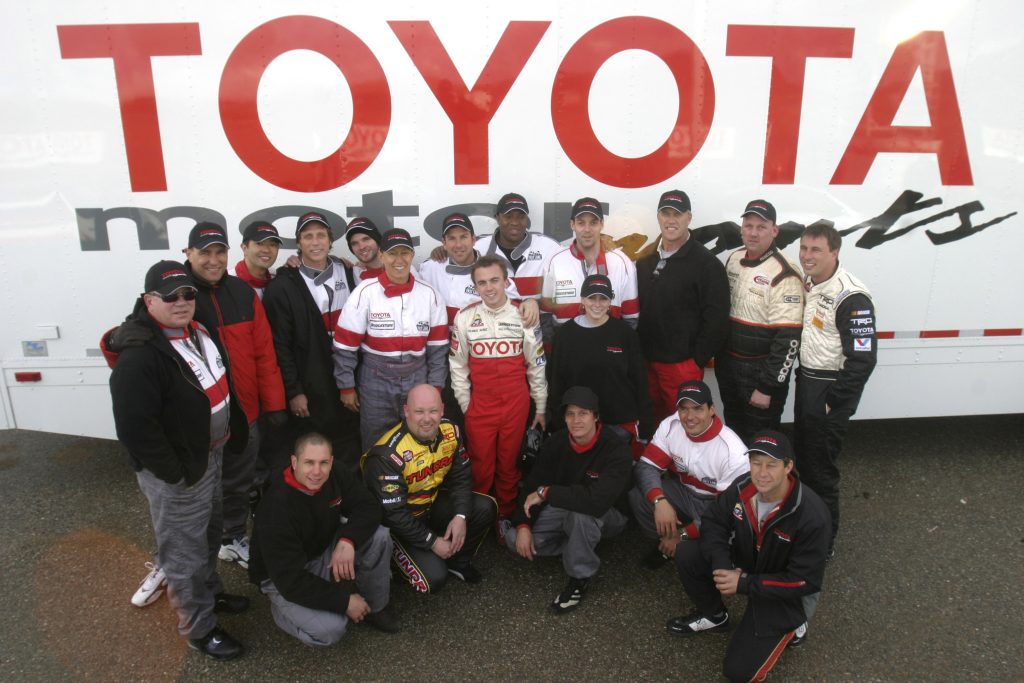
Race participants during the 2006 Toyota Pro/Celebrity Race Training Day at Willow Springs Raceway. (Jonathan Alcorn/WireImage via Getty)
* * * * *
The first pro/celebrity race in Long Beach is more properly described as a celebrity pro race. It was 1975, the year of the inaugural Long Beach Grand Prix. Two marketing mavens at Toyota had the bright idea of using local heroes to burnish the company’s modest sporting image. Before the featured Formula 5000 race, SoCal racing legends Dan Gurney, Phil Hill, and Bob Bondurant roared around for a few laps in Celica ST liftbacks along with two-time Formula 1 World Champion Graham Hill. It wasn’t a big deal, and nobody remembers what happened.
The next year, even as the Grand Prix was upgraded from F5000 to F1, the pro/celebrity race shrank further from the spotlight. Billed as the Race for Youth Match Race, it inexplicably pitted three female racers with meager reputations against three car magazine editors with wire-rim glasses. Like the previous year, it wasn’t a big deal, and nobody cares what happened. (For the record, then-Car and Driver editor Don Sherman, now a regular Hagerty contributor, won after surviving some first-corner argy-bargy.)
It wasn’t until 1977 that the Toyota Pro/Celebrity Race finally lived up to its name. Cars were built at the Vel’s Parnelli Jones Racing shop in nearby Torrance, and safety mogul Bill Simpson ran the show. Sam Posey beat Shelly Novack, a Los Angeles Ram-turned-television star, by less than a second, and a tradition was born.
In later years, star power dimmed, occasioning questions like “Joshua who?” and “Is she somebody?” But early on, the fields included incandescent names from movies (Clint Eastwood, Gene Hackman), television (William Shatner, James Brolin), sports (the decathalete known at the time as Bruce Jenner, Lynn Swann), music (Paul Williams), comedy (Dick Smothers), even the space program (Pete Conrad.) Ditto for the pros. Consider the roster in the 1980 race alone—Parnelli Jones (who won), Dan Gurney (who set fast lap), Rick Mears, Alan Jones, Kyle Petty, Don Prudhomme, Tom McEwen, David Hobbs, Neil Bonnett. Not a poseur among them (which wasn’t the case later on, when celebs were promoted to the pro ranks after winning as an amateur).
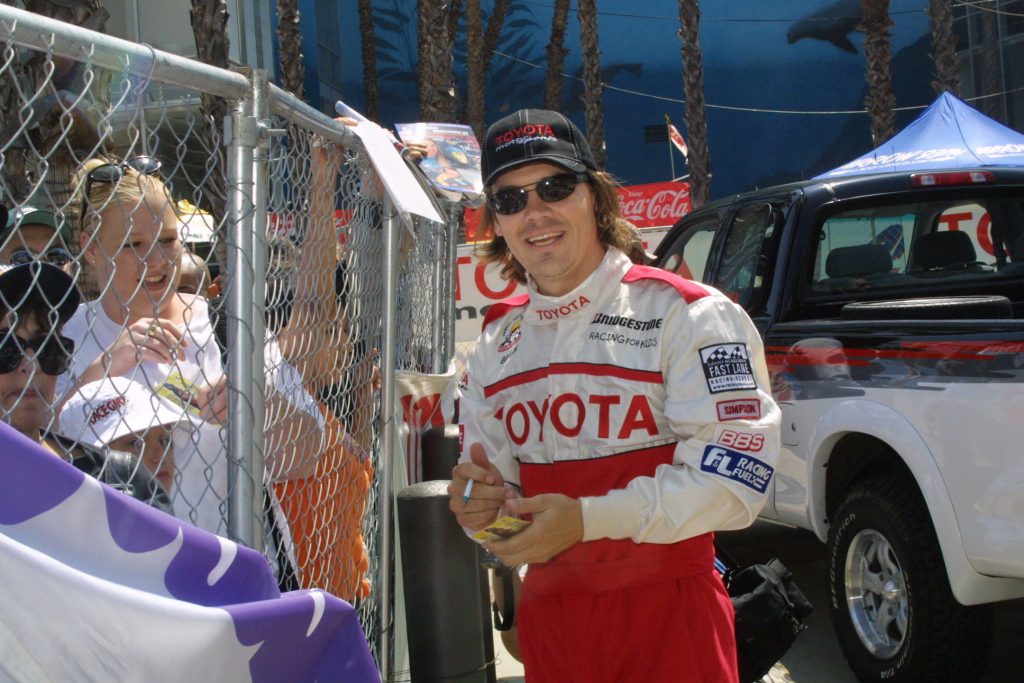
Actor Josh Brolin poses for a photo at the 25th Annual Toyota Pro/Celebrity Race, 2001. (Newsmakers/Getty Images)
The next big red-letter date for the race came in 1984, when Les Unger was installed as Toyota’s national motorsports manager. As the field marshal presiding over the company’s grand racing strategy, Unger oversaw Toyota’s ambitious forays into Indy cars and NASCAR. His portfolio also included sports car racing, off-road racing, Pikes Peak, Toyota Formula Atlantic, and various grassroots programs. But the pro/celebrity race was his baby, and he was hands-on from the welcome dinner to the post-race bash.
“Les Unger is the reason I was in the race,” says Kim Coates, who first raced in 2012, when he was starring in Sons of Anarchy. “It begins and ends with him. I remember being in the balcony, watching my boy Billy Fichtner [who won the race in 2011 as a cast member of Entourage]. And there’s Les Unger, silver hair, big sunglasses, looking at me: “‘We’re coming for you next year, buddy!’”
Unger established the template that would be used for the next quarter-century. Celebs had to commit—and this was non-negotiable—to eight days of driver training, racing, and charity meet-and-greets. Although Toyota didn’t pay the participants, the company sunk a ton of money into the program. Think about it: Food, lodgings, transportation, mechanics, race gear, and pesky personal services, not to mention administration, insurance, promotion, and contracting with a booking agency to secure headliners. Oh, and lots and lots of driver instruction. And then there were the cars—two dozen brand-new ones built every time a fresh model of Celica or Scion (the tC and then the FR-S) debuted. Altogether, there were eight iterations.
Chuck Wade and Marty Schwerter spent two decades building, prepping and repairing the vehicles—over and over and over again. “They beat the crap out of those cars,” Wade says. Vehicles came off the assembly line as regular production models. Upgrades included roll cages, coilovers, heavy-duty clutches, fire systems, and bigger front brakes. Although the pro/celebrity cars weren’t built to any particular spec, Wade and Schwerter generally followed the SCCA playbook. “We wanted them to be easy enough for an amateur to drive but good enough for a pro to enjoy,” Wade says. “Juan Pablo Montoya liked the ZZT231 [Celica] so much that he asked us to build him a street-car version without the roll cage.”
Unger is coy about exactly how much Toyota spent on the program. Many, many millions, certainly. But if generating publicity was the goal, and it was, then that was money well spent. Prior to Unger’s arrival, the race had always been something of a sideshow. With Unger cracking the whip, it was transformed into must-see TV.
“It was talked about in New York City. It was talked about in Boston. It was talked about in Miami,” he says. “The Long Beach event was one of a kind. There were other promoters who looked at what we did and said, ‘Oh, anybody could do that.’ But after a year or two, they found that it was a LOT of work to do it right. They didn’t have the commitment that we had from the company. No other manufacturer ever came close to going to the level that we did. It’s never going to happen again in any form.”
* * * * *
Like Perry King, William Fichtner vividly remembers getting propositioned by Toyota.
“When I got the invitation, I said, ‘Oh, I’m IN!,’” he says. “The pro/celebrity race isn’t like pro/celebrity golf or tennis. It’s like, holy shit, it’s a REAL DEAL race! I’m a motorsports fan. But I’m in SAG. I’m not a race car driver. At Willow Springs, they were talking about shifting the weight to the front tires, and I had no idea what they were talking about.”
Enter Danny McKeever, described by his biographer as “America’s Driving Instructor to the Stars.” McKeever was serving as the chief instructor for the California Sports Car Club, the local region of the SCCA, when Unger put him in charge of getting the celebrities up to speed. Handsome, affable, professional and chill, McKeever was the ideal dude for a job that required dealing with everyone from divas to … difficult people.
To be fair, McKeever insists that most of the celebrities were low-maintenance. “There were a few who were troublesome, but we didn’t see too many egos,” says his son, Dan, who now runs Ford’s high-performance driving programs. “For the most part, they were good to work with.” But they posed some unique driver-instruction issues. Generally speaking, the people who sign up for driving schools already know at least some of the basics. Not so the students at Willow Springs. Many of them had never driven a stick shift before. Rapper Lil’ Kim had never driven, period. Obviously, heel-and-toeing was an alien concept, and most of the celebs never mastered the technique.

Lil’ Kim in pit lane during the 2004 Toyota Long Beach Grand Prix Pro/Celebrity Race. (Jonathan Alcorn/WireImage via Getty)
One actress was inexplicably slow on the straightaways until an instructor realized she was heel-and-toeing on UPSHIFTS. Of course, this was preferable to the more common practice of simply dumping the clutch and zinging the motor. William Shatner alone was reputed to have popped four or five engines. “I can’t tell you how many transmissions we rebuilt over the years—at least 150,” Schwerter says with a sigh.
Several celebrities bailed during or after training, when they finally realized what they’d gotten themselves into. One badass NFL star bowed out because his mother told him she thought racing was too dangerous. Simon Cowell voted himself off the program when it became clear that he couldn’t make it through a session without pitting for a smoke break. But Unger says the only participant he ever disinvited was lead guitarist Eddie Van Halen, who took an early curtain call after incurring a racing-while-intoxicated citation.
McKeever’s challenge was teaching newbies not only how to drive fast but also how to race wheel-to-wheel, which is the difference between shadow boxing and cage fighting. This entailed compressing a solid week of instruction into four days. Naturally, accidents happened. Both Lorenzo Lamas, then a regular on Falcon Crest, and Woody Harrelson, who was playing a lovably dimwitted bartender on Cheers at the time, rolled their Celicas at Willow Springs. Later, instruction was moved from the “big” track, billed as “The Fastest Road in the West,” to the slower Streets of Willow Springs circuit.
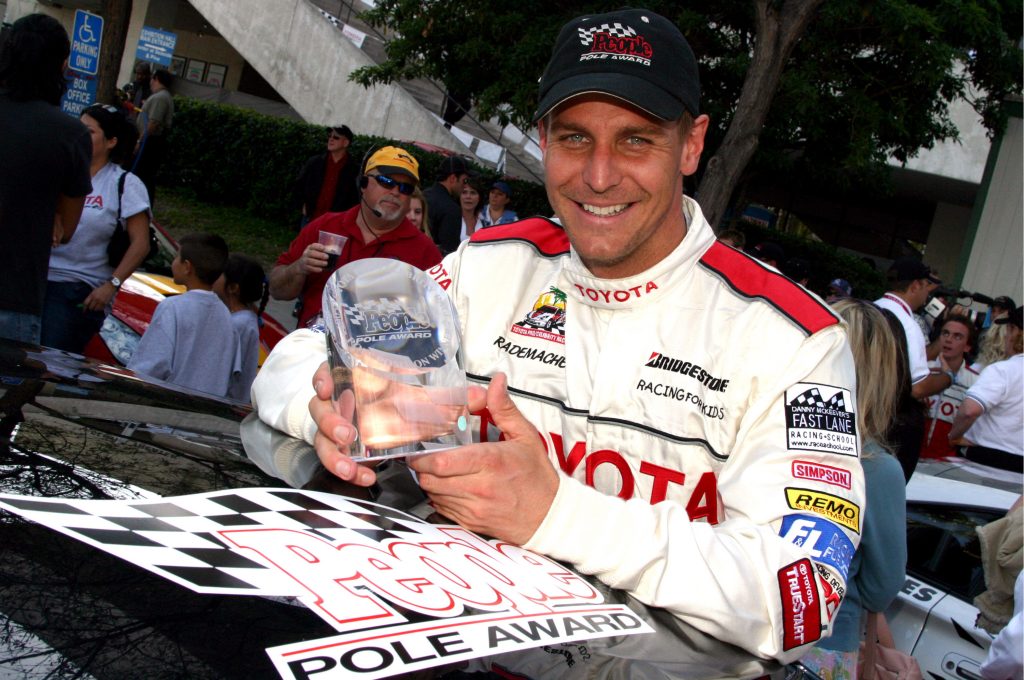
Ingo Rademacher of General Hospital, had the fastest qualifying time and started pole position for 2005 Toyota Pro/Celebrity race in Long Beach. He is holding the People Magazine sponsored Pole Award. (Photo by Jonathan Alcorn/WireImage)
Mishaps notwithstanding, a handful of celebs proved that America’s got driving talent. X Games types tended to cross over seamlessly—snowboarder Shaun Palmer, BMXer Dave Mirra, skateboarder Bucky Lasek. Sean Michael Flannery, aka young Indiana Jones, was super quick. Soap opera star Ingo Rademacher outqualified drift/rally ace Rhys Millen in 2005 before crashing—twice!—during the race. Bruce Jenner, Dick Smothers, Patrick Dempsey, Craig T. Nelson, Tim Allen, Jason Priestly, and Frankie Muniz all graduated to professional racing. Academy Award-nominee actor Josh Brolin (son the aforementioned James) dogged Scott Pruett through the field in 2001 and might even have passed him if he hadn’t missed a shift. Afterward, Pruett walked Brolin over to Trans Am car owner Paul Gentilozzi and said, “You’ve got to give this guy a test.”
But these were the outliers. “At the end of the day, they ended up being a pretty average group of folks,” Dan McKeever says. McKeever isn’t throwing shade here, just stating the obvious: Most people slot into the heart of the bell curve. Which, of course, was the problem. Or, depending on your perspective, maybe it was what made the pro/celebrity race such a hoot.
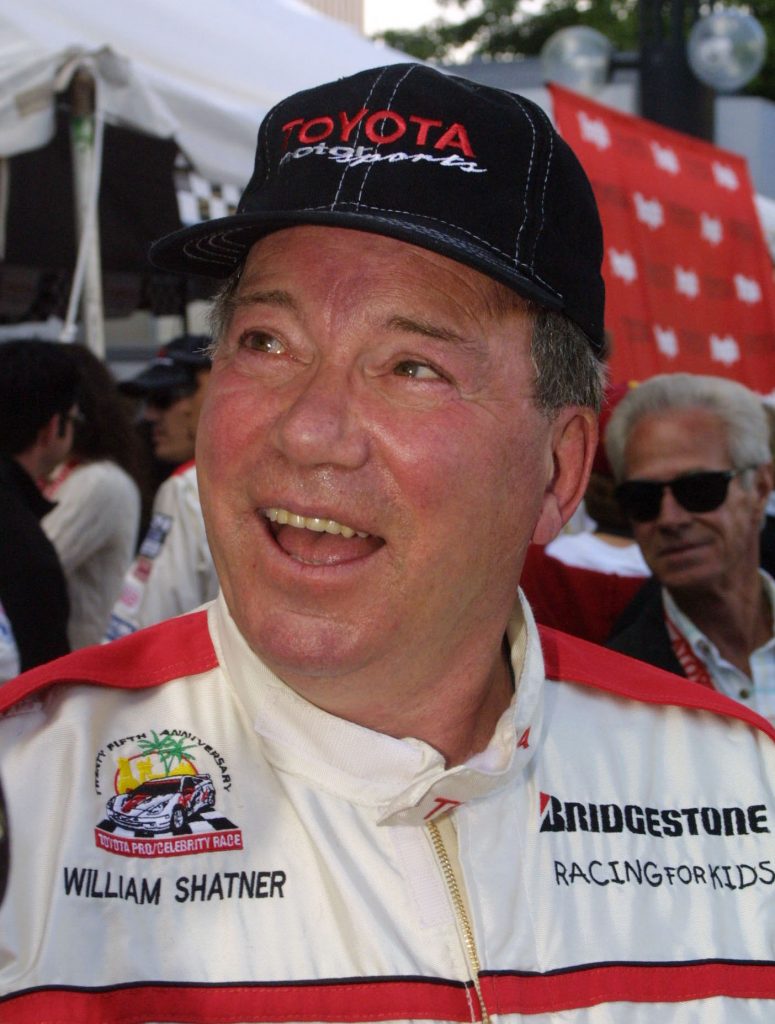
Actor William Shatner in good spirits at the 2001 race. (Newsmakers/Getty Images)
Say you wanted to create the ideal conditions for an epic crash fest. Where would you start? Well, you’d cherry-pick a group of ultra-competitive high-fliers with marginal car-control skills and minimal racing experience. You’d strap them into identically prepared cars that they don’t have any equity in or responsibility for. Then you’d put them on a tight, twisty, technical, super-demanding street circuit ringed by unforgiving tire walls and concrete barriers. Add a few thousand spectators. Mix in a little red mist. Can you say disaster waiting to happen?
* * * * *
You want bumping and grinding? You want slicing and dicing? You want crashing and burning? Welcome to the 2010 edition of the Toyota Pro/Celebrity Race.
Jimmy Vasser was the fastest qualifier in a supercharged Scion tC, with Tanner Foust and Steve Millen next in line. But since they were pros, they started 30 seconds behind the celebs, and Zachary Levi, who played the title character in the TV drama Chuck, claimed pole position. Oscar winner Adrien Brody led virtually from the start. Behind him, the action was frenetic. On Lap 2, BMX rider Jamie Bestwick wrecked. Meanwhile, Foust dogged Vasser as they shredded the celebrities. “I don’t know what got into him, man,” Vasser said later. “He was really trying to push me off the track. I think he’d been talking to Paul Tracy too much.”
Ditto for the rest of the drivers, who were using each other as brake markers while regularly swapping places in the hairpin. “I had Adam Carolla, and we started banging it out,” Beverly Hills 90210 mainstay Brian Austin Green said. “He’s behind me, and he’s bumping me, so he got in front of me, and I thought, ‘You know what? I’m going to return the favor. I’m going to stay right on him.’ And I just kept banging, and I got in his head a little bit.”
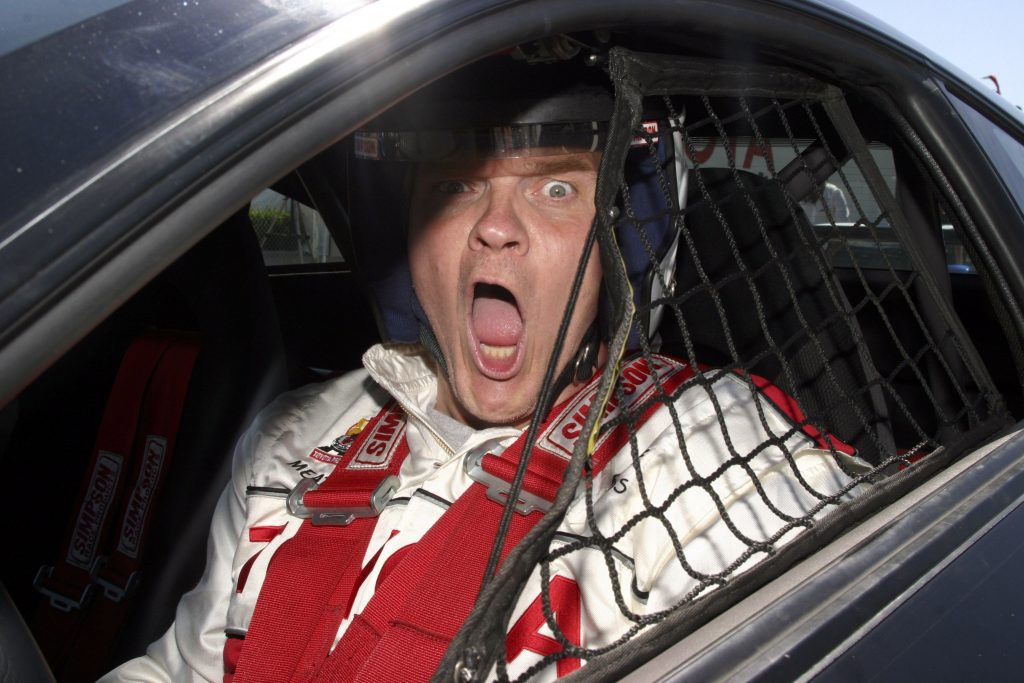
Meat Loaf at practice preparing for the 2005 Toyota Pro/Celebrity race. (Jonathan Alcorn/WireImage via Getty)
On Lap 7, singer Jesse McCartney overcooked it at the end of Shoreline Drive and plowed into the tire barrier at Turn 1. Fifteen seconds later, while corners workers frantically waved flags and arms like sailors on semaphore duty, Toyota dealer Chris Ashworth T-boned the stricken Scion. “I saw him coming,” McCartney said, “and I actually had time to strap in tighter, and I said, ‘Let’s do it.’”
After Ashworth was extricated from his foreshortened car, it erupted into what Pasadena Star-News reporter Dave Werstine felicitously described as a “car-becue.” Five laps of full-course yellow followed. After the restart, Brody led—until he was molested by a horde of marauding Scions at the hairpin. “It started as a good race, turned into an obstacle course and then bumper cars,” he said after finishing fifth in a car with flapping bodywork.
Aided by a bump draft from Foust, Vasser wrestled the lead away from Green going into Turn 1 on the last lap. Foust got trapped behind Green, whom he booted—hard. “At the fountain, I got into oil,” Foust said. “I was 100 percent on the brakes, and I STILL got into the back of Brian Austin Green so hard that I almost drove him into the tires.”
Green got the message and smartly moved over. In the end, Vasser beat Foust by 0.645 seconds, with Green third. “I’ve never seen that much carnage on the track, cars burning up,” Vasser said after the race. “This is not natural. There is no banging in open wheel. I’ve never been tossed around like that. I feel violated.”
* * * * *
“I HATED that event,” Chuck Wade says emphatically, like a man who’s spent years bottling up his true feelings. “It was super stressful. Every driver was a significant person, and it was dangerous with all those walls around there. Grant Show [of Melrose Place fame] hit the wall, and the mirror came into the cockpit and cut his face. It wasn’t anything serious. But it was HIS FACE.”
Because the cars were so stout—and because Schwerter made sure the cars couldn’t go faster than 104 miles per hour—injuries were rare, and none of them were serious. Ironically, the most traumatic incident occurred not during the race but after it. In 2002, wrestler Bill Goldberg yanked the shift lever clear out of its housing while chasing Dara Torres. This wasn’t entirely unheard of: Los Angeles Raider Anthony Smith snapped off THREE gearshift levers in 1994. But Goldberg was so enraged that he beat on the roof on his car until he broke a bone in his wrist.
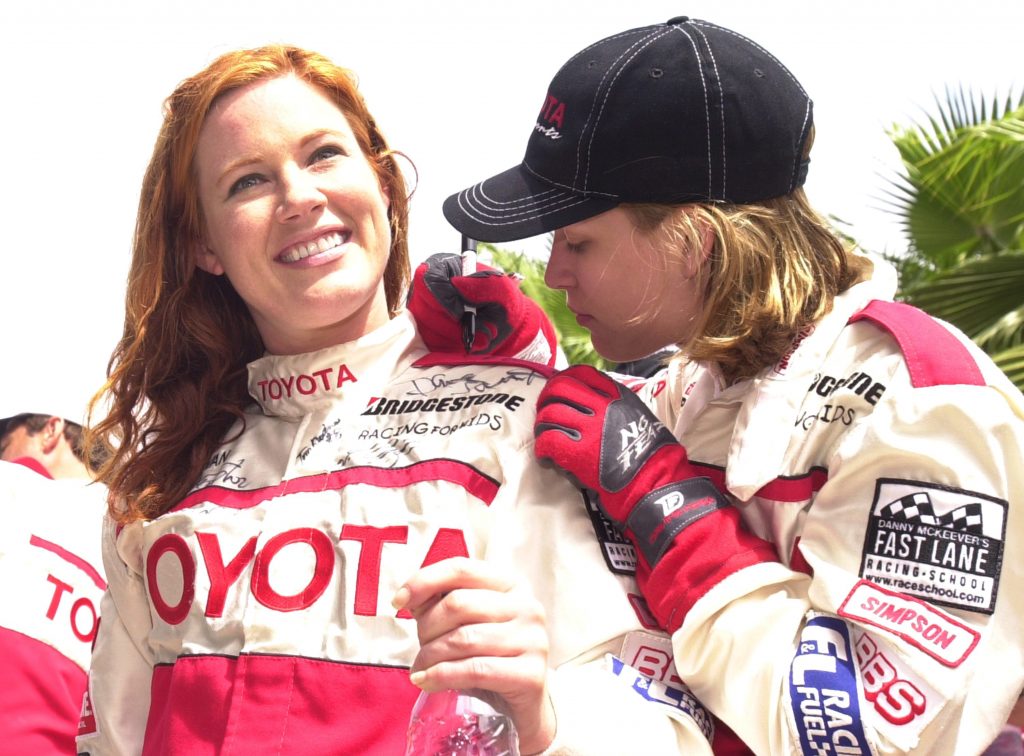
Actresses Elisa Donovan, left, and Piper Perabo autograph each other’s jumpsuits after the 2001 race in Long Beach. (Chris Weeks/Liaison via Getty)
Wrecks were par for the course. In 1981, a camera car—an innovation that was promptly and unceremoniously deleted afterwards—hit not one but two celebrity cars. Two years later, wild man rocker Ted Nugent won celebrity bragging rights “after colliding with everything except the starboard side of the Queen Mary,” according to fellow racer, Los Angeles Times writer Paul Dean. In 1985, singer Jackie Jackson crashed two cars and was carted off on a stretcher. (X-rays were negative.) Two years after that, disc jockey Hollywood Hamilton did his best to make good on his promise to hit every car in the field. Perry King ended up in the wall, with his Celica totaled. “That’s the only time I’ve ever been hurt in a race car,” King says.
Rarely did a race go by without somebody crunching the tires protecting the exit of Turn 1, the sharp corner after the long blast down Shoreline Drive. Pop idol Donny Osmond, who won overall in 1991, flipped there eight years later. In 2011, after qualifying on the pole, actor Steven Moyer pulled the same stunt. HBO executives then forbade him from racing, lest he miss an episode of filming True Blood. But the most impressive Turn 1 fail belongs to producer/director/F1 superfan George Lucas, who clipped a car while making a banzai passing maneuver and backed it into the tires, where he was then center-punched by the car he’d sideswiped in the first place.
On the other hand, a lot of celebrities were content to enjoy life in the slow lane. Comedian Wanda Sykes was famously last by a country mile in 2013. Still, she looked like Speed Racer next to Lil’ Kim, who trundled around the track in the wrong gear, happily honking her horn at cheering spectators. But the artist Wyland, who created the sea-themed mural adorning the Long Beach Arena, was in a class—and race—of his own. He’d painted one of his celebrated whales on the hood of his car. When the race started, he was so afraid of damaging his handiwork that he went straight to the back. “Wyland!” a heckler yelled. “You should have painted a turtle on the car!”
Naturally, the pros copped a different attitude—kill or be killed. Most of them relished the opportunity to hobnob with the celebs, and they spent a lot of time showing the rookies the quick way around Willow Springs. But once the scene shifted to Long Beach, the visors came down and the Game of Thrones action commenced.
During the early years, epic battles were fought between SoCal’s two aging lions, Dan Gurney and Parnelli Jones. “They wanted to beat each other SO bad,” says Parnelli’s son, PJ. The duels between them played out like video games, with the celebrities cast as hapless props. In 1992, PJ raced against his father, and he too treated it like mortal combat. “My dad was NOT going to beat me,” he says. PJ duly won overall, outrunning Parnelli and making mincemeat out of the celebrities. “It was like dodging chicanes,” he recalls. “Some of them had no clue.”
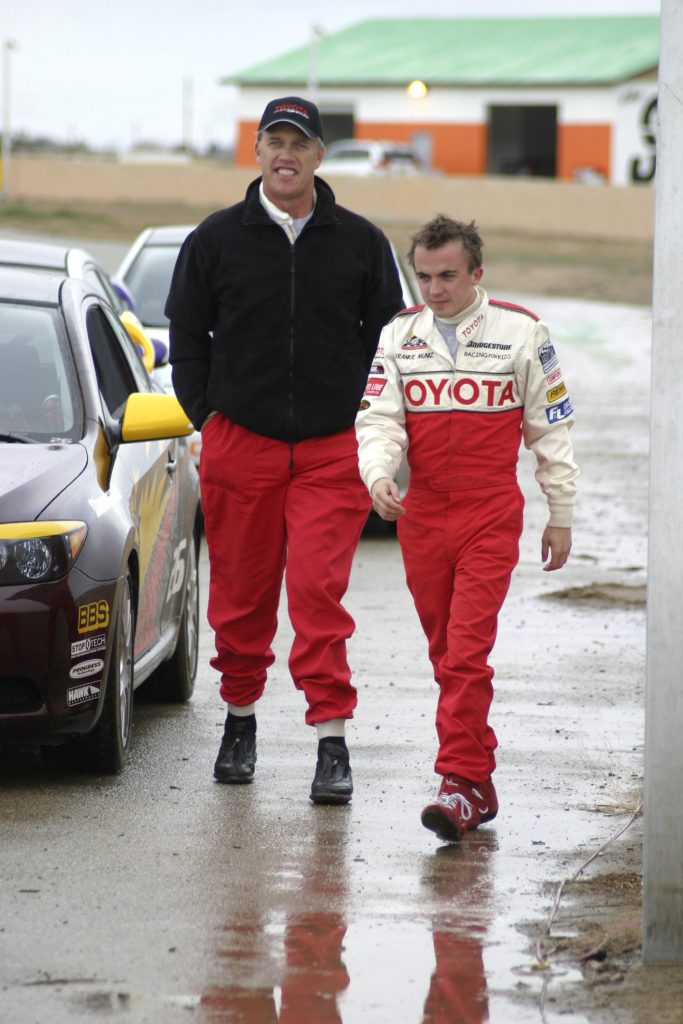
John Elway and Frankie Muniz milling around during training ahead of the 2006 event. (Jonathan Alcorn/WireImage via Getty)
Tommy Kendall was at the center of two classic pro-on-pro battles. In 1997, he got stuck behind Jack Brabham, who’d been famously difficult to pass while winning three F1 championships. Brabham spent several laps looking almost exclusively in his rear-view mirror as he blocked Kendall—until Kendall spun him around. “Either he didn’t see me next to him or he’s never seen a Trans Am race. I don’t give up my space easily,” Kendall said later.
Kendall regretted his decision not to use the chrome horn again five years later. In the driver’s meeting before the race, he’d said to Danica Patrick, “Let’s raise the stakes. Whoever wins gets to lead the other down pit lane by a leash and collar.” Sure enough, Patrick became the first woman to win the pro portion of the race, while Kendall became the first four-time Trans Am champion to be paraded through the Indy car paddock like a pet poodle.
By the time the last of the pro/celebrity races was held in 2016, when Fresh Prince of Bel-Air costar Alfonso Ribiero won for the record fourth time, the fizz had come out of the bottle. The haters had been bitching for years about the declining celebrity quotient of the participants. But, honestly, the appeal of the race had never been proportional to the buzzworthiness of the stars. Even though the event was called a pro/celebrity race, it was really aimed at Everyman.
Except for the most terminally deluded race fans, we all realize that we’re not Mario Andretti. We understand that, if we were miraculously transported into the cockpit of an Indy car, we’d not only terrify ourselves but also look like complete idiots. But in our heart of hearts, I suspect, most of us believe that we could have climbed into one of those Celicas or Scions and waxed the celebrities while outrunning the pros. It was a fantasy, of course, but isn’t that what Hollywood’s been selling for the past century?
At one level, the critics were right. The pro/celebrity sports spectacular wasn’t a REAL race. No reputations were made. No championships were won. But the race usually produced more action in 20 minutes than an F1 Grand Prix generated in an hour and a half. Did it matter? Not in the grand scheme of things. Was it fun? Was it ever. So I keep dreaming that Toyota will revive the race one of these days. And that I’ll get a call from Les Unger, saying, “We’re coming for you next year, buddy!”
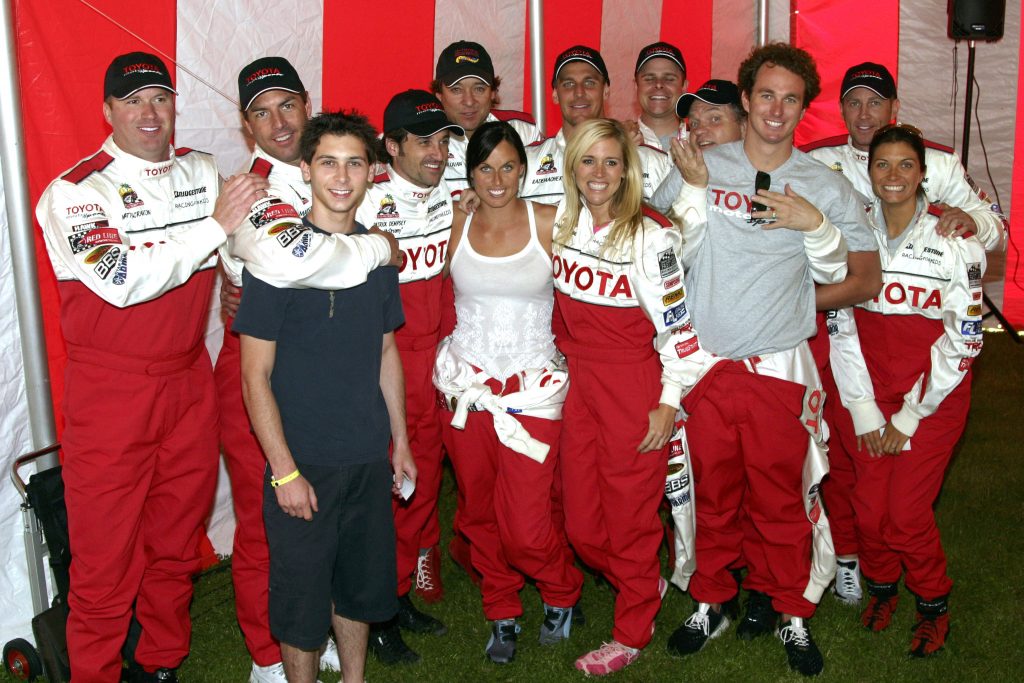
2005 Pro/Celebrity driver roster. (Jonathan Alcorn/WireImage via Getty)

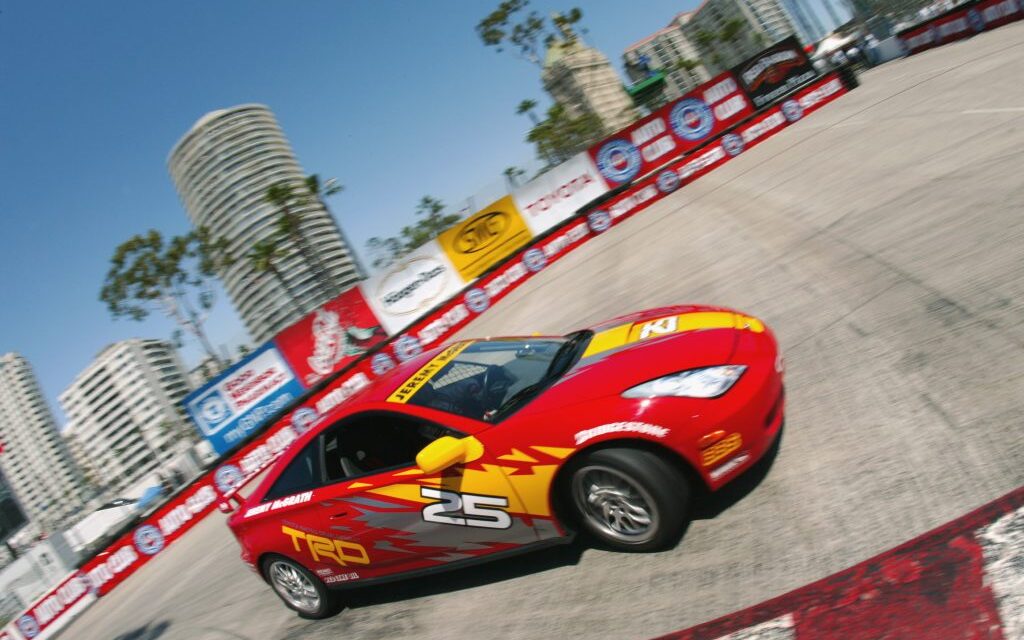
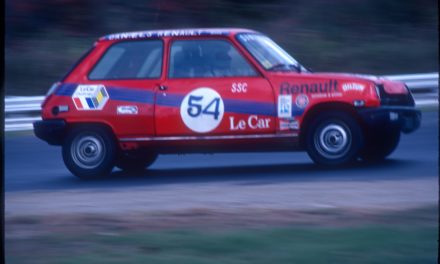
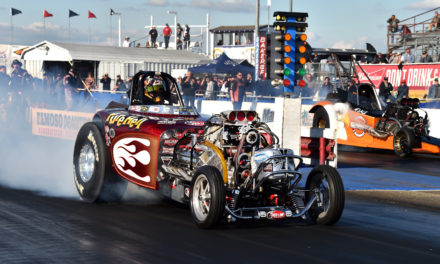
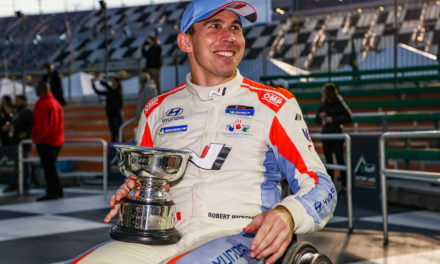
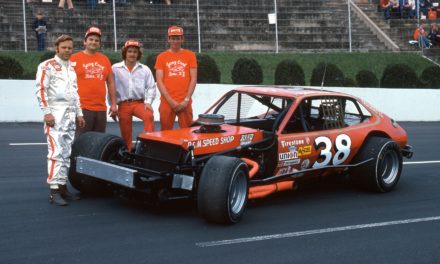





I witnessed many of those races on my attendance to the GPLB. Alas, the last one was red-flagged when George Lucas crashed in turn one. The Force was not strong with him that dark day. 😉
What a great look back in time at a really fun event. I remember watching some of these races too. Hope they bring it back. Terrific article.
How about that Toyota Celica celeb race at Watkins Glen before the 1978 F1 race. Don Prudhomme and Paul Newman amongst many others…
Prior to ‘Ducati chick’ it was ‘Norton bird,’ eh?